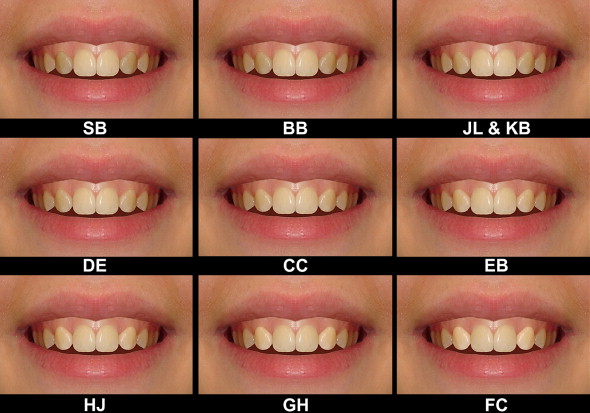Introduction
This study was conducted to determine whether variations in the morphology, size, or shade of maxillary canines would influence perceptions of smile attractiveness in patients with canines substituted for missing maxillary lateral incisors.
Methods
A smiling photograph of a hypodontia patient who had had orthodontic space closure with maxillary canines replacing the lateral incisors was digitally modified to create a bilaterally symmetrical image. Four groups of images were created, digitally altering canine gingival height, crown tip height, canine width, and canine shade. Three groups of judges (40 orthodontists, 40 dentists, and 40 laypeople) ranked the images for smile attractiveness, also scoring the most and the least attractive of each of the 4 groups, and the most and least attractive of all images.
Results
Canine gingival height was the most attractive 0.5 mm below the gingival margin of the maxillary central incisor and progressively less attractive with increasing gingival height. Increasing canine width, increased canine tip height, and pointed canines were perceived to be unattractive. Brighter than normal shades of canines were preferred to darker shades. Narrow canine crowns were most frequently ranked as the most attractive overall, 1.5 mm narrower was preferred by the orthodontists and dentists, and 3.0 mm narrower was preferred by the laypeople. All 3 groups ranked the darkest image, 20 times darker than the original, most frequently as the least attractive image overall. There was good general agreement between orthodontists, dentists, and laypeople for all 4 parameters of smile attractiveness, although laypeople demonstrated greater intragroup variations.
Conclusions
The morphology, size, and shade of the maxillary canine in patients having orthodontic space closure and lateral incisor substitution can have a marked effect on perceived smile attractiveness.
Editor’s comment
Although implant dentistry has progressed substantially in the past 30 years, some patients who are missing maxillary lateral incisors are still best treated with canine substitutions. Facial profile, posterior occlusion, and dental crowding are just 3 factors that could convince the orthodontist to close the lateral incisor space and place the maxillary canine next to the central incisor. However, because the crown lengths of the canine and central incisor are similar, if an orthodontist simply aligns the cusp of the canine at the same level of the incisal edge of the central incisor, then the gingival margins of these 2 teeth will also be at the same level. Would the general public regard this as unattractive? What about the color of the canine crown? These teeth are typically darker than the central incisor. Does the darker canine crown look unattractive to the lay public? Or how about the width of the maxillary canine? The lateral incisor crown is typically about 65% to 75% the width of the central incisor. The maxillary canine is substantially wider than the lateral incisor. Does this imbalance in relative crown width make the person’s smile look less attractive? Finally, the shape of the maxillary canine cusp is pointed, whereas a lateral incisor has a flat incisal edge. Does this difference in incisal edge morphology make the patient with canine substitution appear less attractive? All of these morphologic differences could play a role in reducing smile attractiveness. But which of these factors is most important in the perception of the general public. Which parameter is second most important? Third? Fourth? The purpose of this study was to determine the impact of alterations in the size, shape, color, and position of the maxillary canine on the perception of smile attractiveness by the general public, orthodontists, and general dentists.





